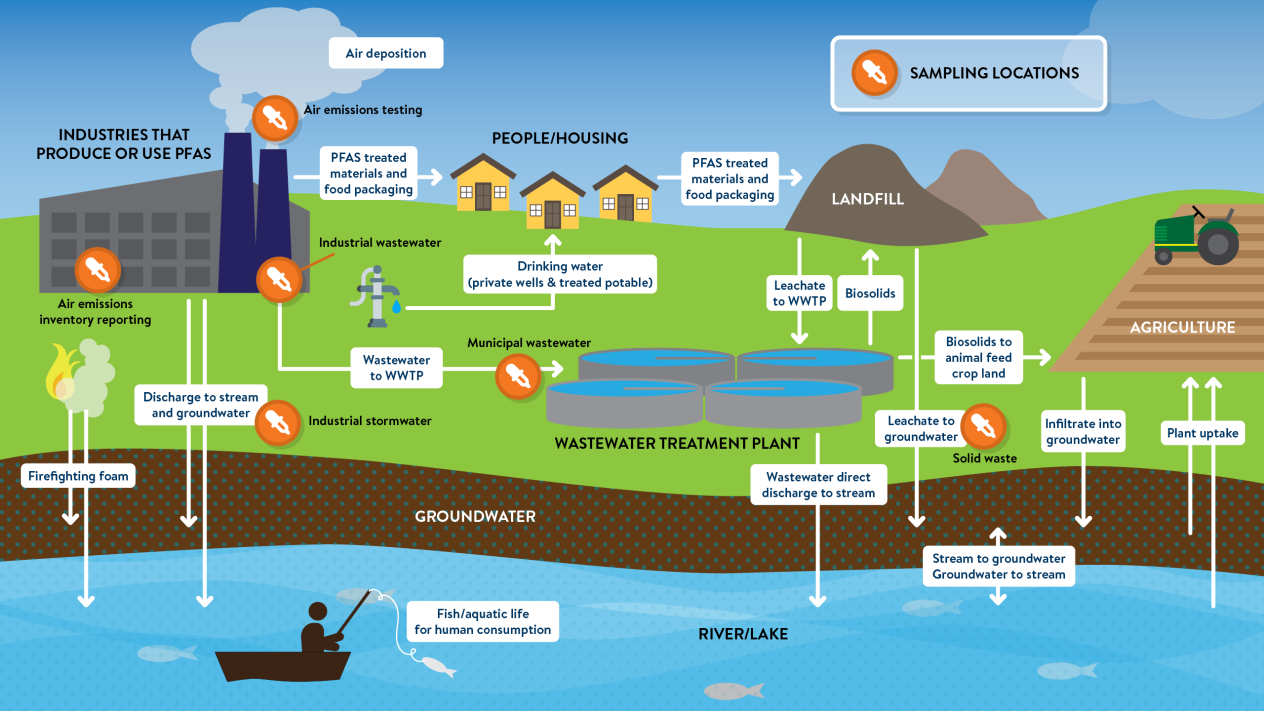Understanding the PFAS Cycle

In recent years, the acronym PFAS has become shorthand for one of the most pressing chemical pollution challenges of our time. Standing for per- and polyfluoroalkyl substances, these synthetic compounds are used in numerous commercial and industrial processes. Because PFAS was manufactured by scientists, they’re often called “forever chemicals” due to their inability to break down.
But PFAS aren’t just dangerous because of what they are. They’re dangerous also because of how they move—through the air, water, soil, products, animals, and humans—in a repeating cycle. This pattern is known as the PFAS cycle, and it's a key reason why governments and industries around the world are now grappling with new regulations, lawsuits, and public scrutiny.
The cycle can bebroken down in four key stages:
1. Manufacturing
2. Environmental Spread
3. Human Exposure
4. Re-entry
Manufacturing:
The PFAS cycle begins where most things do: with production. PFAS have been used since the1940s in numerous consumer and industrial products. During manufacturing or everyday use, PFAS leak into the air, water, and soil. The more we use them, the more they spread—and because they don’t degrade, they start to pile up.
Environmental Spread:
Once released, PFAS moves through wind, rain, snow, and runoff. Industrial sites and wastewater treatment plants are key entry points into the environment. They are then absorbed by plants and animals, moving up the food chain over time because they don't degrade. This increased concentration of PFAS ingested by organisms is called biomagnification.
Human Exposure:
Most people are exposed to PFAS through drinking contaminated water, eating contaminated food, and using PFAS-contaminated products. The National Academies estimated that in NHANES 2017–18 data, 98% of the U.S. population had combined PFAS serum levels ≥ 2 ng/mL, and about 9% had total PFAS ≥ 20 ng/mL. In communities near industrial plants or military bases where PFAS-containing firefighting foam has been used, those levels are often dramatically higher. PFAS, unlike some other toxins, doesn’t exit the body quickly. PFAS exposurehas been linked to various diseases and risks, including increased cholesterol levels, cancer, and thyroid disease.
Re-entry:
Even after disposal of PFAS products, PFAS can re-enter the environment through land runoff and sewage spread on farmland, looping PFAS right back into soil, water, and crops.
Understanding the PFAS cycle shows us that these chemicals recirculate, creating lasting public health and environmental consequences. The more we understand the PFAS cycle, the more equipped we are to disrupt it.
Breaking that cycle isn’t just about awareness; it demands data-driven action and smarter infrastructure.
As manufacturing isa critical step in the PFAS cycle, EcoPulse wanted to utilize our AI-powered platform helps companies detect, track, and manage PFAS usage and exposure across materials, products and across their supply chains, assisting with PFAS compliance and mitigation actions.
Sources:
1. Resilinc Editorial Team. “Pfas Lawsuits and Legislation: Manufacturing Supply Chain Compliance.” Resilinc, 20 Dec.2024, resilinc.ai/blog/pfas-legislation-and-lawsuits/.
2. Oram, Brian. “Pfas and Forever Chemicals – a New Man-Made Cycle (the PFAS Cycle) That Must Be Broken.” KnowYourH2O, 7 May2024,shop.knowyourh2o.com/blogs/news/pfas-and-forever-chemicals-a-new-man-made-cycle-the-pfas-cycle-that-must-be-broken.
3. Cousins, Ian T., and Jana H. Johansson. “Outside the Safe Operating Space of a New Planetary Boundary for Per- and Polyfluoroalkyl Substances(PFAS) | Environmental Science & Technology.” ACS Publications, 2 Aug. 2022,pubs.acs.org/doi/10.1021/acs.est.2c02765.
4. Photo from: MPCA charts how to prevent and manage PFAS pollution after tracking its movement |Minnesota Pollution Control Agency

